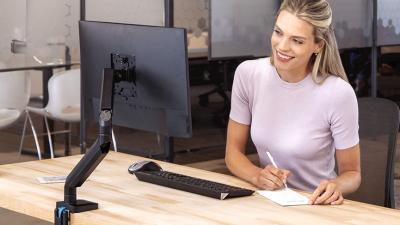
Think of all the hours a day you spend looking at your computer monitor in your job. This is why positioning your monitor correctly for an ergonomic setup is crucial, and not a minor detail.
The word ‘suffer’ is spot on when we discuss musculoskeletal disorders (MSDs). These disorders affect your joints, bones and muscles and sometimes associated tissues such as your nerves, and can cause serious pain. According to the Health and Safety Executive (HSE), 543,000 workers suffered from MSDs in 2023/24 in the UK, resulting in 7.8 million lost working days.
But did you know that work-related musculoskeletal disorders can be caused by a poorly set-up workstation? How you position your monitor has an effect on your posture when working.
Here, I’ll share simple and effective ergonomic guidance for your computer monitor, which helps to save the day.
For health, comfort, and productivity, I’ll explore how to position single or dual monitors in relation to your body so that your posture feels natural and comfortable and your vision is effective and relaxed. An ergonomic monitor setup, together with taking breaks from the screen and moving, puts minimal stress on your body while you work at your desk.
Why ergonomic monitor setup matters

Pain is the last thing you need in your busy and challenging job, if you can possibly prevent it.
The key benefits of an ergonomic monitor setup are all about health and comfort. Get it right and take plenty of movement breaks, and your setup will help you prevent health problems and reduce strain on your shoulders, neck, arms and eyes. Your wellbeing and productivity at work will receive a welcome boost.
Here's why your ergonomic monitor setup matters:
- Poor monitor positioning has a negative impact on your posture and, consequently, your health.
- Ergonomic monitor setup is featured in the important DSE Regulations that the Health and Safety Executive (HSE) instruct employers to train their staff in. ‘DSE’ stands for ‘Display Screen Equipment’ and these are the health and safety regulations which computer users should follow – for optimum wellbeing and musculoskeletal risk reduction. This guidance covers the equipment you use at your computer workstation including your keyboard, mouse, and chair, as well as your monitor.
- The official Display Screen Equipment (DSE) workstation checklist includes ensuring your ‘Eyes are at roughly the same height as the top of the screen’. This Posturite diagram shows this monitor positioning. Also see the helpful ‘Posture tips for comfort at your desk’ webinar.
- Common issues resulting from poor monitor setup include visual fatigue and discomfort and a poor posture, which may then lead to neck and back pain. We’ll look at these in more detail in the next section.
- Adjusting a workstation in line with ergonomic principles is important for your long-term wellbeing. Could you be doing office work for 50 years of your life? It’s possible. Quick, simple setting up of your ergonomic chair, desk, monitors, keyboard and mouse does enhance your health and comfort, and this small effort will pay off. Good ergonomics also improves your performance and satisfaction at work.

Signs you need to improve your monitor setup
Some typical signs that can indicate you might need to improve your monitor setup are:
- You work with your chin tilted upwards
- You’re jutting your head forward to read text
- You’re leaning on your desk
- You have to squint your eyes to see
- You experience fatigue or eyestrain
- Your back, shoulders or neck ache

Take a look at the Posturite ‘Finding The Right Monitor Position’ factsheet to learn more.
Step-by-step guide to an ergonomic monitor setup
Follow the ergonomic monitor setup tips and you’ll be reducing your risk of pain. It’s that simple!
Step 1: Adjust the monitor height
Using a screen that’s too low or too high can put strain on your neck, causing pain and tension in your muscles and making it uncomfortable to work.

- For ideal eye level positioning if you sometimes look down at the keyboard to type, your eyes should be level with the top part of your screen.

- If you’re a touch typist (and therefore look down less often), your eyes should be in line with the top third of your screen.
- If you wear bifocal glasses, the advice is slightly different. Your monitor should be positioned a little below eye level and tilted back 30° to 45° for optimal viewing comfort. This helps you to look through the correct part of your bifocal lenses for closer work, without changing your neck posture.
You could use a monitor stand, also known as a monitor riser, to help you get the monitor height right. The Fellowes Premium Monitor Riser has five stacking height adjustments for you to choose from.
You could opt for a clear see-through monitor stand like the BakkerElkhuizen Q-Riser 140, (pictured below left) or the low-cost Breyta™ Monitor Riser in black or white (below right) - it has a handy ledge for your mobile phone at the front as well as charging cable access.

Top tip: An adjustable monitor arm would give you an even better result for your ergonomic monitor setup due to its extra flexibility, and will also free up space on your desk. It will help your desk setup to look stylish and sleek too.

Monitor arms do provide the most ergonomic method to ensure your screen is at the correct height and angle for you. The ergonomic Platinum Series™ Single Monitor Arm with an in-built cable management system features smooth gas spring technology to easily adjust the height of your monitor. You connect it to your desk via the clamp or grommet.
Step 2: Position the monitor at the right distance

Ergonomists recommend that the distance from your shoulders to your computer screen should be:
- About an arm’s length, or 50-65 cm.
This guidance of ‘an arm’s length’ makes it very easy to check and correct!
Again, use an ergonomic monitor arm to help you position your monitor at the correct distance.
Step 3: Adjust the screen viewing angle and tilt
One of the risk assessment checklist items to help you comply with the DSE Regulations for health and safety asks ‘Does the screen swivel and tilt?’. The right tilt is an important part of an ergonomic monitor setup.
- It’s ideal to have the top of the monitor tilted back a little: 10° to 20° backwards is recommended.
- Place your main monitor directly in front of you to reduce twisting your body.
Get up and take a look at your screen from a sideview to check the tilt angle. A monitor arm is great for helping you to adjust the tilt.
A useful ergonomic monitor setup infographic is on the Finding The Right Monitor Position factsheet to download and keep.
I’d add that it’s comfortable to have a ‘visual zone’ (ie where you look at the majority of your documents and what you’re reading) of around 30 degrees.
Step 4: Reduce screen glare and reflections

Glare and reflections on your monitor screen at your workstation can cause eye discomfort and headaches. They can also simply be irritating: an aspect of ergonomics is reducing irritations so you can carry out a task effectively and enjoyably. Here are the recommended solutions:
- Position your desk at a right angle to natural light sources.
- If this isn’t possible, you’ll need to install window blinds to stop direct sunlight (blinds with vertical slats are popular in offices), or use an arm-mounted sun shade which you can move around, such as the SuperVisor Clamp Mount Anti-Glare Screen. A hood around your monitor screen could also work, so consider the Adjustable Anti-Glare Screen Hood.
- A further very good option is an anti-glare filter for your screen; these are easy to attach.
Get more workplace eyecare tips in the 10 hacks for fighting digital eyestrain infographic.
If you’re not sure if you have a glare on your screen, a good tip is to turn the screen off and sit in your usual position to view it. On the dark screen, glare will show.
Step 5: Adjust the screen brightness, contrast and text size

Now make some adjustments to further:
- Reduce the strain on your eyes.
- Prevent squinting and the poor posture of leaning forward to read text on the screen.
Adjust the brightness of your display according to the brightness of your room rather than leaving it at the default setting. On my PC, I go to ‘Settings’ and then ‘System’ and then ‘Display’ to access my screen brightness settings. Both excessively bright or excessively dim settings can strain your eyes, so choose a setting that’s comfortable for you. 100% brightness on your screen is too bright; I tend to go for 75%.
The default text size on your computer may be 150%, but you can change it to suit you in your settings. If it’s too small for you, you’ll experience discomfort from squinting.
Dual monitor setup for ergonomics

Do you like having multiple monitors to work from? Here are some ergonomic tips for dual monitor setup:
- Place your main monitor in front of you – the one you use most often.
- If you use both monitors equally, when looking directly ahead your eyes should be at the middle join of the monitors when side by side.
- Make sure the two monitors are the same height where possible.
- Have the two monitors the same distance away from you (about an arm’s length).
- For dual-screen productivity, make sure a laptop or tablet is your secondary monitor, for reference only.
Don’t be tempted to sit too far away from your two screens because of the larger screen area. The recommended distance remains at 50-65 cm. To reduce the risk of eyestrain, use zoom controls.
A dual monitor arm is brilliant for enhancing your ergonomic setup.
For setting up three monitors, the advice regarding matching height and distance is similar to the advice for a single monitor setup. Place the monitor you use most frequently directly ahead of you, and use the side monitors for reference, to minimise head rotation.

For four monitors, you can use stacking monitor arms, and have two monitors at the top and two monitors directly underneath. Arrange your work to have the least used monitors at the top.
Extra tip: taking breaks from your monitor

There are two huge reasons to take multiple short breaks (aka microbreaks) away from your monitor as often as you can:
- For your eye health and vision: breaks help to avoid tired eyes and headaches. Follow the 20-20-20 rule: At least every 20 minutes, look at something 20 metres away for 20 seconds. It’s also good for your vision to vary close visual tasks with looking further away. Blinking keeps our eyes hydrated, but when we stare at a screen, our blink rate reduces.
- Breaks are the perfect chance to change your posture and move too, to help prevent back ache and to benefit your overall health.
If you follow all the positioning tips in this blog - yet forget to take screen breaks - you won’t be following ergonomic best practices or complying with DSE regulations. Work breaks are crucially important to your health and safety.
Taking a walking break during the working day is highly recommended by workplace wellbeing experts.
Final thoughts
My aim here has been to convince you of the long-term health and productivity benefits of an effective ergonomic monitor setup, whether you work from home or in the office. Go on – make the recommended changes now to your posture and the position of your monitor – and feel the difference in comfort and pain reduction.
If you’re interested in using a sit-stand desk or standing desk, remember that you won’t have to change your monitor positioning every time you change from sitting to standing and vice versa – your monitor will just move with your desk, and this will keep things simple.
If you’d like to talk to a professional about your ergonomic setup – perhaps if you’re experiencing pain and discomfort – you can book a DSE assessment and you’ll receive personalised recommendations.
If you need help choosing the right monitor arm or monitor stand, you can also chat online for free to the ergonomic product experts at Posturite.
Your monitor is just one aspect of a good workstation which gives you full ergonomic efficiency. You should also take extra care to adjust your ergonomic chair and learn to position your mouse and external keyboard correctly. This way you enjoy better posture and happier, more comfortable working.
Read next:
Watch next:















